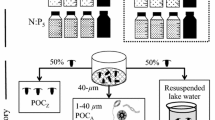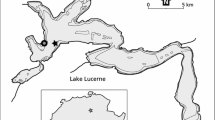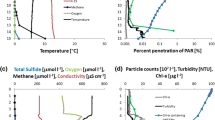Abstract
Previous studies have shown that (a) a large portion of theannual total organic carbon (TOC) inputs to central Ontario lakes iseither lost to sediments or degraded and lost via evasion to theatmosphere, (b) the partitioning of organic carbon between sediments andthe atmosphere appears to be a function of acidity and (c) UVirradiation can account for observed long-term loss of TOC from thewater column. These findings were extended by examining whether acidityenhances photo-oxidative losses of TOC. Stream waters (initialalkalinities between −97 and 233 µeq l−1)were incubated in UV-transparent containers under incident solarradiation for periods ranging from 14 to 23 days. The highestphoto-oxidation rates occurred when alkalinity was negative. Additionsof acid and base to stream waters increased and decreasedphoto-oxidation rates, respectively. The exceptional clarity ofatmospherically acidified lakes is usually attributed to increasedprecipitation of Al-organic carbon complexes but may instead be due tohigher photo-oxidation rates of allocthonous organic carbon leading tohigher evasion rates of CO2.
Similar content being viewed by others
References
Amador JA, Alexander M & Zika RG (1989) Sequential photochemical and microbial degradation of organic molecules bound to humic acid. Appl. Environ. Microbiol. 55: 2843-2849
Bertilsson S & Tranvik LJ (1998) Photochemically produced carboxylic acids as substrates for freshwater bacterioplankton. Limnol. Oceanogr. 43: 885-895
Blough NV, Zafiriou OC & Bonilla J (1993) Optical absorption spectra of waters from the Orinoco River outflow: terrestrial input of colored oragnic matter to the Caribbean. J. Geophys. Res. 98: 2271-2278
Brezonik PL & Fulkerson-Brekken J (1985) Nitrate-induced photolysis in natural waters: controls on concentrations of hydroxyl radical photo-intermediates by natural scavenging agents. Environ. Sci. & Technol. 32: 3004-3010
Cole JJ, Caracao NF, Kling, GW & Kratz TK (1994) Carbon dioxide supersaturation in the surface waters of lakes. Science 265: 1568-1570
Dillon PJ, Molot LA & Scheider WA (1991) Phosphorus and nitrogen export from forested catchments in central Ontario. J. Environ. Qual. 20: 857-864
Dillon PJ & Molot LA (1997a) Dissolved organic and inorganic carbon mass balances in central Ontario lakes. Biogeochem. 36: 29-42
Dillon PJ & Molot LA (1997b) Effect of landscape form on export of dissolved organic carbon, iron, and phosphorus from forested stream catchments. Water Resour. Res. 33: 2591-2600
Effler SW, Schafran GC & Driscoll CT (1985) Partitioning light attenuation in an acidic lake. Can. J. Fish. Aquat. Sci. 42: 1707-1711
Ferguson A (1998) Autotrophic and Heterotrophic Bacterial Carbon Production in Two Temperate Lakes with Contrasting Food Web Structure. Masters thesis, York University, Toronto, Canada
Gao H & Zepp RG (1998) Factors influencing photoreactions of dissolved organic matter in a coastal river of the southeastern United States. Environ. Sci. Technol. 32: 2940-2946
Haag WR & Hoigne J (1985) Photo-sensitized oxidation in natural waters via OH radicals. Chemosphere 14: 1659-1671
Lindell MJ, Graneli W & Tranvik LJ (1995) Enhanced bacterial growth in response to photochemical transformation of dissolved organic matter. Limnol. Oceanogr. 40: 195-199
Kling GW, Kipphut GW & Miller MC (1991) Arctic lakes and streams as gas conduits to the atmosphere: implications for tundra carbon budgets. Science 251: 298-301
Larson RA & Weber EJ (1994) Reaction Mechanisms in Environmental Organic Chemistry. Lewis Publishers, Boca Raton, U.S., 443 pp
Markager S & Vincent WF (2000) Spectral light attenuation and the absorption of UV and blue light in natural waters. Limnol. Oceanogr. 45: 642-650
Mierle G & Ingram R (1991) The role of humic substances in the mobilization of mercury from watersheds. Water Air Soil Pollut. 56: 349-357
Miller WL & Moran MA (1997) Interaction of photochemical and microbial processes in the degradation of refractory dissolved organic matter from a coastal marine environment. Limnol. Oceanogr. 42: 1317-1324
Miller WL & Zepp RG (1995) Photochemical production of dissolved inorganic carbon from terrestrial organic matter-significance to the oceanic organic carbon cycle. Geophys. Res. Lett. 22: 417-420
Molot LA & Dillon PJ (1996) Storage of terrestrial carbon in boreal lake sediments and evasion to the atmosphere. Global Biogeochem. Cycles 10: 483-492
Molot LA & Dillon PJ (1997) Photolytic regulation of dissolved organic carbon in northern lakes. Global Biogeochem. Cycles 11: 357-365
Moore CA, Farmer CT & Zika RG (1993) Influence of the Orinoco River on hydrogen peroxide distribution and production in the eastern Caribbean. J. Geophys. Res. 98: 2289-2298
Moran MA & Hodson RE (1990) Bacterial production on humic and nonhumic components of dissolved organic carbon. Limnol. Oceanogr. 35: 1744-1756
Moran MA & Zepp RG (1997) Role of photoreactions in the formation of biologically labile compounds from dissolved organic matter. Limnol. Oceanogr. 42: 1307-1316
Obernosterer I, Reitner B & Herndl GJ (1999) Contrasting effects of solar radiation on dissolved organic matter and its bioavailability to marine baterioplankton. Limnol. Oceanogr. 44: 1645-1654
Ontario Ministry of the Environment (1983) Handbook of Analytical Methods for Environmental Samples. Toronto, Ontario, Canada
Petasne RG & Zika RG (1987) Fate of superoxide in coastal sea water. Nature 325: 516-518
Reche I, Pace M & Cole JJ (1999) Relationship of trophic and chemical conditions to photobleaching of dissolved organic matter in lake ecosystems. Biogeochem. 44: 259-280
Schindler DW (1998) A dim future for boreal waters and landscapes. BioScience 48: 157-164
Strome DJ & Miller MC (1978) Photolytic changes in dissolved humic substances, Verh. Inter. Ver. Limnol. 20: 1248-1254
Tranvik LJ & Kokal j (1998) Decreased biodegradability of algal DOC due to interactive effects of UV radiation and humic matter. Aquat. Microb. Ecol. 14: 301-307
Voelker BM, Morel FMM & Sulzberger B (1997) Iron redox cycling in surface waters: effects of humic substances and light. Environ. Sci. Technol. 31: 1004-1011
Waite TD & Morel FMM (1984) Photoreductive dissolution of colloidal iron oxides in natural waters. Environ. Sci. Technol. 18: 860-868
Zepp RG & Cline DM (1977) Rates of direct photolysis in aquatic environments. Environ. Sci. Technol., 11: 359-366
Zepp RG, Faust BC & Hoigne J (1992) Hydroxyl radical formation in aqueous recation (pH 3-8) of Iron(II) with hydrogen peroxide: the photo-Fenton reaction. Environ. Sci. Technol. 26: 313-319
Zepp RG, Hoigne J & Bader H (1987) Nitrate-induced photooxidation of trace organic chemicals in water. Environ. Sci. Technol. 21: 443-450
Author information
Authors and Affiliations
Corresponding author
Rights and permissions
About this article
Cite this article
Gennings, C., Molot, L.A. & Dillon, P.J. Enhanced photochemical loss of organic carbon in acidic waters. Biogeochemistry 52, 339–354 (2001). https://doi.org/10.1023/A:1006499713835
Issue Date:
DOI: https://doi.org/10.1023/A:1006499713835




